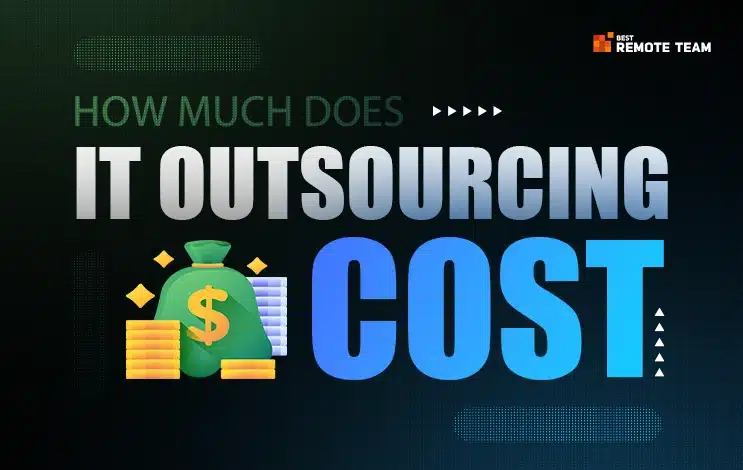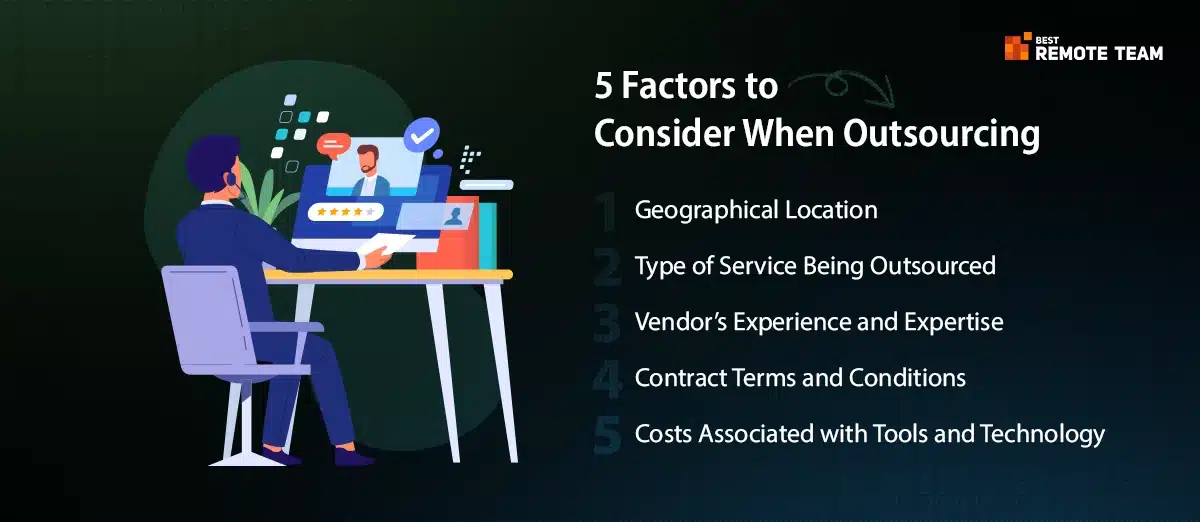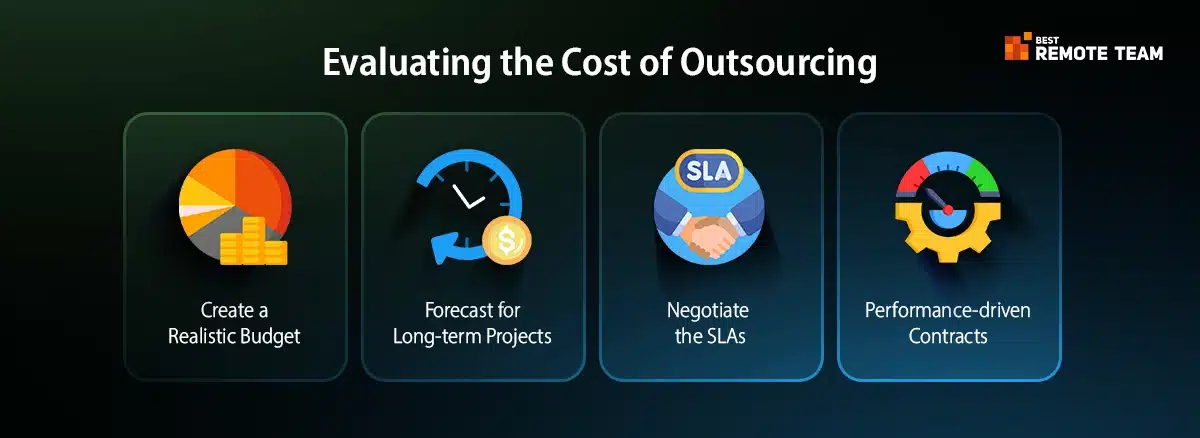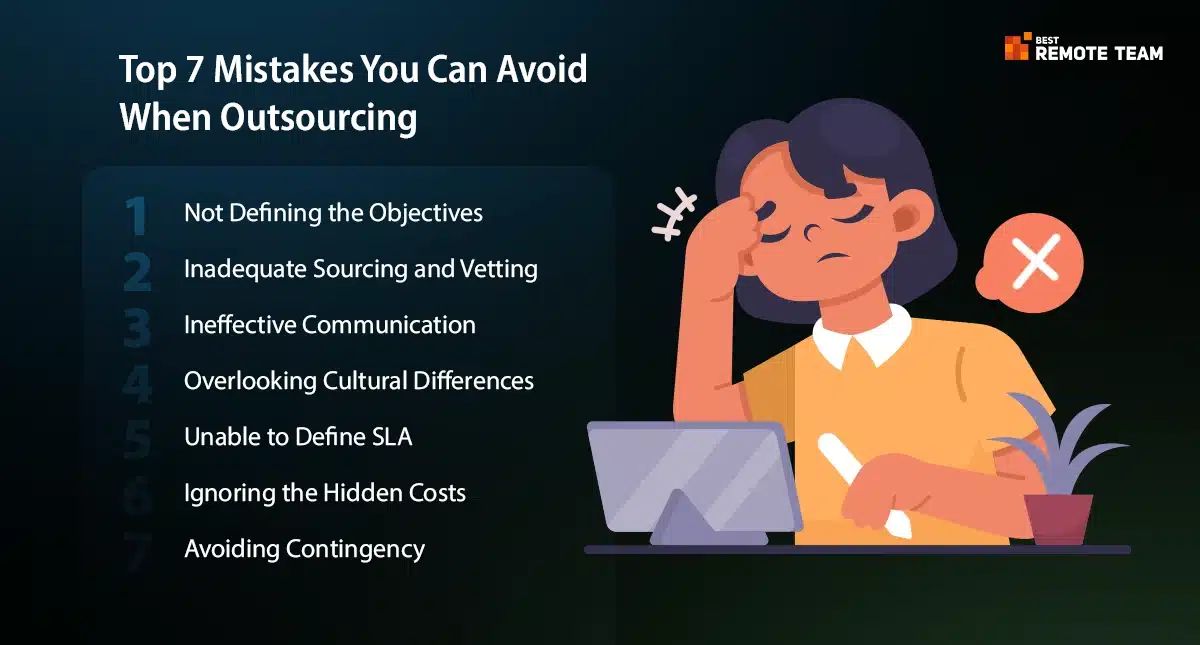5 Key Factors Influencing the Outsourcing Costs
When you are calculating the outsourcing costs, there are several factors to consider. We will take you through the top five factors that impact the overheads.
1. Geographical Location
The outsourcing location is pivotal in calculating the costs. Each region has a different pricing system, depending on the cost of living and other factors.
Asia is a popular region for outsourcing software development as it is a cost-effective and resource-heavy location.
- Geographical Location: region-wise cost and the effects of nearshore vs offshore outsourcing approach. A lot of businesses outsource their software development requirements to countries in Asia like India and Philippines. These countries tend to offer competent rates and are resource-intensive.
- The Eastern European region is the next favourite among Asian countries. The countries like Poland and Romania are favoured in this region. The reason is lower hourly rates, exceptional language skills and technical expertise.
- Latin American countries like Mexico and Columbia are equally popular owing to time zone similarities and cultural alignment. This proximity allows you to reduce communication barriers and streamline collaboration.
There are two types of outsourcing approaches nearshore and offshore. Nearshore is an excellent option if you want to increase proximity; however, this approach leads to increased hourly rates. Offshore outsourcing is cheaper but it might be culturally different and can pose different challenges.
| Country | Average Hourly Rate (USD) |
| US, Canada | $50-$250* |
| UK, Germany | $70-$150* |
| Ukraine, Poland | $30-$80* |
| India | $20-$70* |
2. Type of Service Being Outsourced
The kind of service you are outsourcing can also influence the overall cost. For instance, if you are outsourcing software development, it will depend on the system maintenance, actual development and tech support provided by the company.
The costs would depend on the complexity and overall scope of the project. If the maintenance is low and the application is basic, the costs would be lower. However, if you plan to outsource a custom software development, you might need to choose the appropriate country and portions for outsourcing. This would attract some amount.
On the other hand, if you are outsourcing customer service, the cost would depend on the type of channel and company you are selecting. If you are choosing an offshore country like Philippines, the cost would be relatively less. However, if you need specialized people who are culturally aligned, you might need to invest in other countries.
The cost structure would depend on the type of service and its complexity. Again the type of service being outsourced will define the outsourcing strategy and budget requirements.
3. Vendor’s Experience and Expertise
The pricing also depends on the experience and expertise of the software development provider who would be your outsourcing partner. The established providers have a proven track record, which means they are likely to charge higher than those with less experience.
They can justify the high price because of consistent deliveries and high-quality services. They will mitigate the risks and ensure fewer errors. With their experience, they can deliver solutions while incorporating the best practices and using robust systems.
The startups and newer vendors, on the other hand, price their services at a lower rate to build a stronger brand. The low cost can be slightly risky. These startups lack the expertise and experience established vendors have.
The cost differences affect several risks and additional costs. It is important to balance the cost with the expertise.
4. Contract Terms and Conditions
This is one of the biggest influences on the outsourcing cost. Factors such as contract terms, pricing details and others can impact the costing decisions.
Fixed price contracts include a set fee along with a defined work scope. Using this pricing model, you can have a defined budget and make sure you are aware of the total cost in the beginning. You can use this contract for defined requirements and strict timelines. In case of contingencies and emergencies, your vendor can always negotiate additional charges. These contract types provide clarity and transparency.
Time and material contracts allow you to charge the providers based on the time spent and the materials added to the project. With this model, you can create a more adaptable solution. however, in this case, you might spend more money than the initial estimated budget. This contract is beneficial when you are working on a dynamic project.
Long-term vs short-term engagement also impacts the outsourcing cost. While long-term contracts offer stability and discounted rates, they may not offer the flexibility you need. Short-term contracts are flexible and adaptable. However, they may become expensive in case your project duration increases.
5. Costs Associated with Tools and Technology
Along with the vendor costs, you must also consider the cost of adopting tools and technology for software development. If they use proprietary software, platforms or tools to deliver the services, it can attract specific costs.
The service fee and other charges are included in these costs. The cost also includes maintenance and upgrades required by the tools and technology. In case of cutting-edge software, IT outsourcing firms may charge more than regular as it adds operational efficiency and accelerates development.
The emerging technologies like Artificial Intelligence and automation can influence the cost of app development and redefine the outsourcing landscape. Using automation, you can reduce the turnaround time and reduce labor costs as well.
Cost Structure of Outsourcing Approach
There are different outsourcing approaches you must consider when planning software development. Each approach has a significant impact on the overall cost of development.
1. Offshore Outsourcing Approach
In this approach, you outsource software development and delivery to a company outside your country. This helps you reduce the cost of development. In this approach, there are a few aspects to consider. The base price is lower offshore when compared to the nearshore development.
In case of offshore outsourcing, you need to consider the costs related to onboarding, integration and initial training. The last aspect to consider is the ongoing management of the software solution.
The hidden costs for offshore outsourcing include communication and quality control expenses. There are the travel expenses as well, which are hidden.
India, Philippines, Vietnam and Bangladesh are popular outsourcing countries for offshore development. You must analyse the strengths and potential challenges of each country before proceeding with outsourcing.
Quick read: The Ultimate Guide to Offshore Software Development
2. Nearshore Outsourcing Approach
In nearshore outsourcing, you partner with companies that are in your proximity or share the location. The companies you are connecting with generally offer higher rates for hourly projects. Despite the extensive cost, you may get some advantages of outsourcing to nearshore companies.
One of the biggest advantages is the ease of travel you get. It is easier to connect and collaborate in person. Moreover, the overall cost is lower when compared to the quality and management.
The other interesting benefits include cultural alignment and time zone similarities, which offer a competitive edge.
3. Onshore Outsourcing
Onshore is when the country or even state is same for both the client and the provider. As the location is the same, the cost would be higher for the client. For instance, if you are partnering with a company in United States, they would be expensive when compared to countries like Mexico.
Moreover, the overhead costs for onshore is higher compared to offshore and nearshore. You would gain an advantage in terms of collaboration and quality. There is a great chance that the partner company resides near you, which means there is zero travel cost involved and better collaboration.
Onshore outsourcing is best considered when you have a complex project on board. This collaboration will help you offer immediate feedback and bring on board the possibility of tight integration. Moreover, it will help them realize the regulatory and compliance needs of your business or industry and they can translate them into the application effectively.
4. Managed Services
This outsourcing approach allows you to outsource specific business and IT functions to a partner company. You would not be outsourcing the entire project but, specific aspects that are core to the third-party business.
The cost structure for this outsourcing approach involves initial setup cost, the subscription expenses and the SLAs. The subscriptions are managed monthly, which involves the cost of support, maintenance and ongoing business. setup includes the initial onboarding and configuration expenses. Lastly, the SLAs are important for timely deliveries and uptime guarantees.
As there is a predictable cost involved for each month, managed services are best fit for those companies that aim to reduce monthly expenditure. It will ensure that you work on managed budgets. It is easier to scale the business with the SLA without exceeding the budget or adding unnecessary requirements.
You can access the expertise of the third-party provider with this managed outsourcing. It will help you develop an application without hiring the talent in your business.
Quick read: How to Solve Modern Hiring Challenges with Talent Acquisition
5. Project-based Outsourcing
The last outsourcing approach involves project-based engagement with a partner company. In this approach, you will work with a software development company for a defined scope and timeline.
The factors that impact the cost of project-based outsourcing include the duration of the project. If you have a long-term project, you might need to negotiate the expenses accordingly. However, if you have a short-term project, it may not be beneficial to you, as the unit costs would be higher for the shorter duration.
The scope of work may also impact the cost of outsourcing. In the case of this approach, the requirements are specific and the deliverables defined, which reduces the need for additional expenses.
The project-based outsourcing should be considered when your project is well-defined with specific goals and requirements. moreover, you should consider it if you have a long-term project need. Lastly, this is beneficial when you need specialized skills with budget constraints.
Strategies for Cost Reduction
Most of these approaches and strategies can increase the overhead for the software development project you are planning. Here are a few effective strategies that can help reduce or manage these costs efficiently.
1. Create a Realistic Budget
You must have a realistic and defined budget for the project you are outsourcing. Start by identifying the project scope, which includes the deliverables and timelines.
You must get quotes from multiple vendors and check the setup or ongoing management. You should also look for hidden costs.
You should also have a contingency plan and factor in communication protocols to ensure you can manage the scope changes.
2. Forecast for Long-term Projects
You must look at the historical records and data to identify a pricing model for the current vendors. You can break down the entire cost into manageable phases, and factor in potential changes as well.
When forecasting, take into consideration inflation and service level changes along with scope adjustment needs. you should also review actual expenditures to align the budget with the project requirements.
3. Negotiate the SLAs
You should negotiate the service level agreements with the vendors after researching the market rates and comparing the quotes. You can use this information to determine the best terms and understand the buyer.
You can also use long-term contracts for lower rates. You should also build a strong relationship with the vendor before proceeding with a long-term partnership.
When you have clear SLAs, you can ensure that the performance standards and responsibilities are mentioned for both parties involved. Moreover, you should also define the metrics for quality, response times and issue resolution.
4. Performance-driven Contracts
This is an essential strategy to improve the cost-effectiveness of outsourcing the project. You can incentivize the results for the quality of work using defined performance standards. This will reduce the risks for the client and tie the entire expense to the performance instead of fixed payments.
Lastly, you can ensure that the spending is controlled by the value received by the client for the project.
To create performance-based contracts, you must have clear metrics and set performance standards. Make sure to link the payments to the performance of the provider. Add incentives to the base fee for better solutions.
Add monitoring and reporting specifications for regular check-ins and evaluations. Lastly, make sure to add dispute resolution approaches to address the issues in a structured format.
Most Effective Techniques To Manage Outsourcing Costs
If you want to effectively track the expenses involved in outsourcing your software project, you should automate specific portions with appropriate tools and techniques.
- The expense management software, such as SAP Concur and Expensify can help monitor the spending and categorize the invoices for immediate reimbursement. It can help track expenses and ensure improved spending.
- The next tool to automate your software project outsourcing is a project management software like Trello and Asana, which can be used to track the tasks, costs and project milestones efficiently.
- Financial reporting tools, such as QuickBooks and Microsoft Excel can help analyse the cost data and financial reports.
- Vendor management systems like Coupa and Ariba ensure swift vendor performance and contract management tracking.
Advantages of Regular Cost Audits
Here is why you should conduct regular and detailed cost audits for your software outsourcing project.
- It will ensure you adhere to the budget. Sometimes, you may go beyond the defined costs or expenses. With the regular audit, you can recognize when your cost goes beyond the defined budget. It will help you identify the deviations and unexpected costs added to the budget immediately and help align with the pre-defined budget.
- You can use the audit to identify the opportunity to reduce the costs. This approach will help determine the inefficiencies within the specific scope and budget as well as vendor contracts. When you reimagine this aspect, you can gain better control of cost savings.
- It can also help maintain transparency and accountability throughout the project. This will help reduce the discrepancies and ensure minimal risks associated with the finances.
- You can enhance your forecasting abilities with greater accuracy using the right financial planning tools with regular audits and analyses.
Top Mistakes to Avoid During Outsourcing
Here are some of the mistakes you can avoid while outsourcing the software project.
1. Not Defining the Objectives
If you are unable to specify the objectives for the project you are outsourcing, it can lead to misaligned expectations. Your software developer may not get clarity regarding the objectives and goals. This can lead to misaligned results.
To avoid this, you must specify the goals and deliverables clearly before hiring dedicated remote developer. This well-documented specification can help manage the communication and achieve the results.
2. Inadequate Sourcing and Vetting
If you skip through proper sourcing and vetting processes, you might find yourself partnering with the wrong provider. To avoid this mistake and ensure smooth outsourcing, you must conduct a detailed background check and review their portfolio. You should also ensure the vendor’s capabilities are aligned with your specific business needs.
3. Ineffective Communication
In case of offshore and nearshore outsourcing, you depend on tools and technologies for effective collaboration and communication. If you haven’t chosen proper methods or aligned the timelines, it can lead to misunderstandings during collaboration and delays.
You should set up a proper communication protocol for this purpose. Ensure you have a proper channel to share regular updates, host meetings and share real-time issues. This would help align the stakeholders with the project.
4. Overlooking Cultural Differences
One of the biggest issues that your project can face is cultural differences. This can cause friction in project completion.
You can address the cultural differences and create a more productive environment with training and proper alignment. Recognizing the differences and working on a strategy for the purpose can help.
5. Unable to Define SLA
If you fail to define the SLA, it can cause vague expectations. This would lead to major disputes that can impact your business project outcomes.
To avoid this, you must have a defined agreement that states the performance metrics and quality standards. Make sure to include the responsibilities that can help hold the vendor accountable for the performance.
6. Ignoring the Hidden Costs
This is a commonly made mistake that can impact the budget of the software development project. You must consider all the costs, such as setup, training and management. You should also consider the potential costs to avoid surprises.
7. Avoiding Contingency
You can face potential issues when you avoid planning for contingency. Despite the defined scope, you might need to pay extra for the scope adjustments. This can lead to budget issues in the long run. You can avoid that by including contingency funds in your budget plans.
Conclusion
Businesses can align outsourcing with their strategic framework to optimize the costs, assess the skills and enhance operational efficiency. Using a successful outsourcing solution, you can ensure careful planning and enhanced communication for better cost management.
It is crucial to manage the outsourcing costs by understanding factors like geographical location, service types and contract terms. You can use the goals and budget to make informed decisions about the approach.
Using structured agreements, vendor selection and regular monitoring to outsource with minimized cost risks. Best Remote Team can help you advance your outsourcing goals with the right technologies, effective cost management strategies and defined vetting processes.
You will get a capable partner to outsource your project and get a competitive edge in the market. connect with our team to get the best outsourcing service provider for your upcoming business need.







